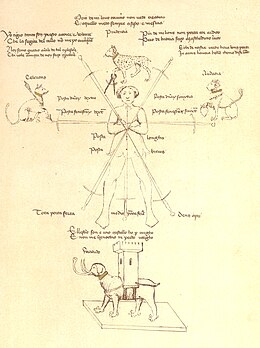Italian school of fencing

|
|
| Also known as | La Scuola Della Spada Italiana |
|---|---|
| Focus | Weaponry |
| Country of origin | Italy |
| Creator | Historical |
| Famous practitioners | Fiore dei Liberi, Filippo Vadi, Achille Marozzo, Antonio Manciolino, Angelo Viggiani, |
| Descendant arts | Modern Fencing |
| Olympic sport | No |
The term Italian school of swordsmanship is used to describe the Italian style of fencing and edged-weapon combat from the time of the first extant Italian swordsmanship treatise (1409) to the days of Classical Fencing (up to 1900).
Although the weapons and the reason for their use changed dramatically throughout these five centuries, a few fundamental traits have remained constant in the Italian school. Some of these are the preference for certain guards, the preoccupation with time (or "tempo") in fencing as well as many of the defensive actions.
Of especial influence was the Dardi school of fencing with the spada da lato in the 16th to early 17th centuries, which gave rise to the classical early modern of fencing with the rapier, including Elizabethan Fencing in England and the French school of fencing in the 18th century (which in turn developed into modern sport fencing).
One of the earliest known Italian treatises on swordsmanship and other martial arts is the Flos Duellatorum (Fior Di Battaglia/The Flower of Battle) written by Fiore dei Liberi around 1409. Fiore's treatise describes an advanced martial arts system of grappling, dagger, short sword, longsword, pollaxe, and spear. Another important treatise, De Arte Gladiatoria Dimicandi, was written by Filippo Vadi sometime between 1482 and 1487. Although different, Vadi's work appears to be based upon Fiore's earlier work. It has been suggested that Vadi's style of swordsmanship represents a transitional phase between that of Fiore and the later Bolognese masters.
The 16th century saw the publication of various works generally focused on the so-called cut & thrust sword, although these works often contained significant instruction on other weapons. A general survey of the 16th-century Italian manuals shows instruction for the following weapon or weapon combinations in at least one published manual:
...
Wikipedia
